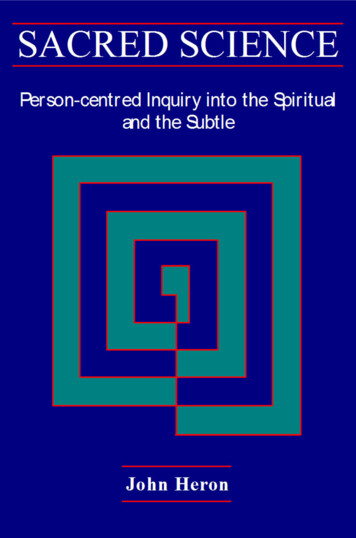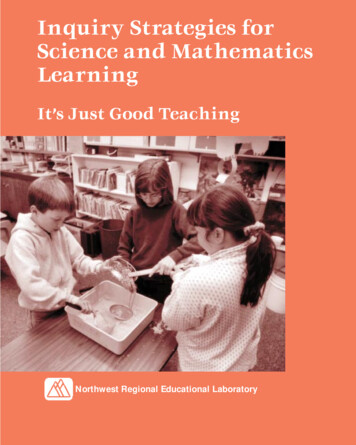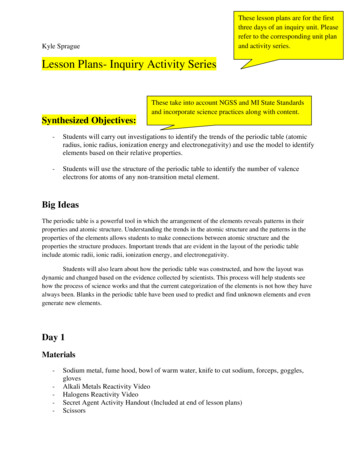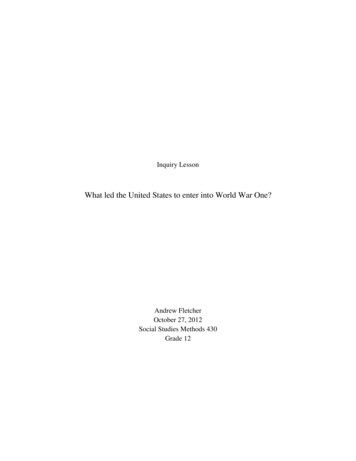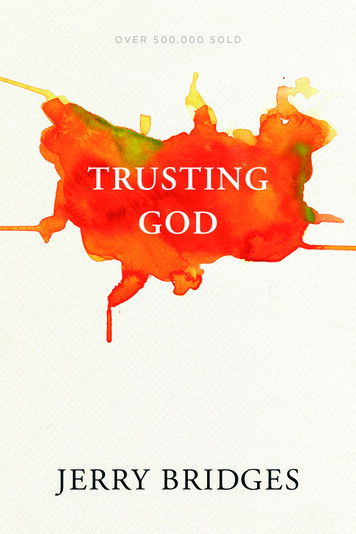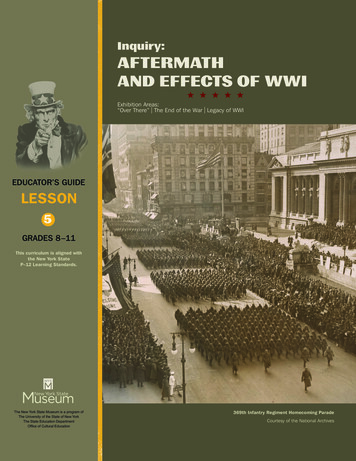
Transcription
Inquiry:AFTERMATHAND EFFECTS OF WWIExhibition Areas:“Over There” The End of the War Legacy of WWIIIEDUCATOR’S GUIDELESSON5GRADES 8–11This curriculum is aligned withthe New York StateP–12 Learning Standards.The New York State Museum is a program ofThe University of the State of New YorkThe State Education DepartmentOffice of Cultural Education369th Infantry Regiment Homecoming ParadeCourtesy of the National Archives
Inquiry:LESSON5OBJECTIVES Students will be able toanalyze short and long termresults of World War I.AFTERMATHAND EFFECTS OF WWIExhibition Areas:“Over There” I The End of the War I Legacy of WWIRATIONALEWorld War I was a turning point in history; the results can still be seen and felt today. This wasespecially relevant as our military was thrust into a situation, with new technology and tactics, inwhich it had to adapt or perish, and we confronted and influenced other groups. Compounded onthis was the lack of government control over the transition from war to peace, social impact uponpolitical and racial groups, and the unbalanced way in which groups or individuals were honoredand rewarded. This lesson, Aftermath and Effects of WWI, brings light to the good and bad ofthe United States’ demobilization process and seeks to remember the sacrifices made by thoseimpacted by the war.HISTORICAL BACKGROUNDIf the United States was ill equipped for war in 1917, it was even less prepared for peaceafter the Allies and Germany signed an armistice on November 11, 1918. No mechanismwas established for the demobilization of millions of men now in military service, forthe care of the wounded, or the difficulties of reintegrating these men into civilian life.The administrative machinery created to organize the war effort was quickly disbanded. Astroop ships arrived in New York Harbor, throngs of cheering citizens along the paraderoutes through the city welcomed the doughboys home. The joyous reception these soldiersreceived was often in sharp contrast to the realities of returning to civilian life. The valorand sacrifices displayed by African American troops in particular was largely forgotten orpurposefully marginalized in the US. Many units composed of African American troopsfelt more appreciated in Europe, and consequently the introduction of jazz music there isaccredited to black regimental bands touring after the war.As demobilization commenced, leaders in New York City feared a massive influx ofdemobilized soldiers would be discharged and saturate the employment market. Effortsensured that soldiers from inland communities and states were not discharged from military service in coastal port cities, but rather were returned to camps closer to their homes.Veterans’ bonuses and pensions were not sufficient for veterans unable to resume theircivilian careers, and little aid was available. Colleges and technical schools were floodedwith returning veterans for years following the war. New York State and the nation struggled to meet the needs of these veterans.The worldwide legacy of World War I is substantial. Globally, more than 17 million peopledied, including over 7 million civilians; another 20 million were wounded. Perhaps the mostsignificant legacy of the Great War, however, was in terms of how much the conflict leftunresolved. World War I was not the “War to End All Wars,” and in fact laid the foundationfor a larger and more deadly conflict just 20 years later. It is critically important to rememberWorld War I today for what it left unresolved, as much as for what the conflict decided.EDUCATOR’S GUIDEGRADES 8–122
LEARNING STANDARDSNew York State Learning Standards: age-arts-and-literacyCCSS.ELA-LITERACY.RH.6-8.7: Integrate visual information (e.g., in charts, graphs, photographs, videos, or maps)with other information in print and digital texts.CCSS.ELA-LITERACY.RH.11-12.6: Evaluate authors’ differing points of view on the same historical event or issue byassessing the authors’ claims, reasoning, and evidence.8.4 WORLD WAR IAND THE ROARING TWENTIES:Various diplomatic, economic, and ideologicalfactors contributed to the United States decision to enter World War I. Involvement in thewar significantly altered the lives of Americans.Postwar America was characterized by economicprosperity, technological innovations, and changesin the workplace. (Standards: 1, 2, 4; Themes: SOC,GOV, ECO, TECH)8.4b International, economic, and military developments swayed opinion in favor of the United Statessiding with the Allies and entering World War I.Domestic responses to World War I limited civilliberties within the United States.8.4c New military technologies changed militarystrategy in World War I and resulted in an unprecedented number of casualties.8.4e After World War I, the United States entereda period of economic prosperity and cultural change.This period is known as the Roaring Twenties.During this time, new opportunities for womenwere gained, and African Americans engaged invarious efforts to distinguish themselves andcelebrate their culture.11.6 THE RISE OF AMERICAN POWER(1890–1920):Numerous factors contributed to the rise of theUnited States as a world power. Debates over theUnited States’ role in world affairs increased inresponse to overseas expansion and involvementin World War I. United States participation in thewar had important effects on American society.(Standards: 1, 2, 3, 4: Themes: GEO, SOC, GOV,ECO)11.6c World War I had important social, political,and economic effects on American society.11.7 PROSPERITY AND DEPRESSION(1920–1939):The 1920s and 1930s were a time of cultural andeconomic changes in the nation. During this period, the nation faced significant domestic challenges, including the Great Depression. (Standards: 1,4; Themes: ID, TCC, SOC, CIV)11.7b African Americans continued to struggle forsocial and economic equality while expanding theirown thriving and unique culture. African Americancultural achievements were increasingly integratedinto national culture.A Spirit of Sacrifice: New York State in the First World War I EDUCATOR’S GUIDE, Lesson 53
5Engage the students in an open-ended discussion about cultural memory—howpeople and societies collectively remember their common history and by what meanspeople seek to commemorate and pay tribute to the past. The following quotes may aidin focusing the discussion on the legacy of the First World War.LESSONWARM-UP:“In a great war for the right, the one great debt owed by the nation is that to the menwho go to the front and pay with their bodies for the faith that is in them.” Theodore Roosevelt, from The Great Adventure: Present Day Studiesin American Nationalism, 1919, page 9“I felt then, as I feel now, that the politicians who took us to war should have beengiven the guns and told to settle their differences themselves, instead of organizingnothing better than legalized mass murder.” Harry Patch, last surviving soldier of World War I“The best memorial for the likes of me would be to look after the soldiers who arestill fighting for their country now, and equally importantly, for their families.” Harry Patch, last surviving soldier of World War I, from The LastFighting Tommy, 2007GUIDED INSTRUCTION:Visit this exhibition gallery via field trip or access our accompanying online exhibition(www.nysm.nysed.gov/exhibitions/WWI) in a classroom setting. Students should focus especially on Exhibition Areas: “Over There,” The End of the War, and Legacy ofWWI. Point out the unique form of combat which defined WWI, highlighting the useof new weapons technology, such as trenches, chemical weapons, machine guns, barbedwire, tanks, submarines and aircraft, and the increased devastation wrought by modernwarfare. Note also how these new forms of warfare produced new and debilitatingtrauma, and what was done (or not done) to respond to the needs of returning soldiers.Additionally, investigate the impact our soldiers had on the spread of jazz, which wasnewly introduced to Europe at that time.INDEPENDENT PRACTICE:In the exhibition, ask students to find specific examples where veterans were remembered, forgotten or marginalized; and how American life shifted back towards peacetime norms. Ask students to find examples of widespread social change after the war.EDUCATOR’S GUIDEGRADES 8–114
ADVANCED PRACTICE:Drawing off this exhibition and elsewhere, the class will divide into groups with each group researching atopic relating to legacy of the First World War. Each group will then present their research to the class andexplain its relevance for today.Suggested topics include: Local WWI memorials in your area Fourteen Points Lasting effects of WWI Women’s roles in war and peace Treatment of black veterans Sgt. Henry Johnson Sgt. William Shemin Introduction of jazz into Europe Pvt. Harry Patch Sgt. Alvin York Shell shock Veteran’s Day Remembering the dead Art before and after WWI League of Nations Weimar Republic Neutrality, Pacifism and Nationalism New York State’s diverse ethnic population Treaty of VersaillesASSESSMENT:Students will be assessed on their understanding of the following: When did the First World War end? Impact of the war on soldiers and society Impact of returning veterans upon society Ways of remembering and honoring the sacrifices people made Why and how sacrifices and people were forgottenTEACHER RESOURCESWorld War I Centennial Commission: http://www.worldwar1centennial.org/National History Day, Teaching World War I: he Great War on PBS: ational Education Association, World War I: http://www.nea.org/tools/lessons/60045.htmTeacher Vision World War I: resources/6679.htmlNOTEWORTHY NEW YORKERS:Sgt. Henry Johnson, New York native, Medal of Honor Recipient: http://www.army.mil/medalofhonor/johnson/Sgt. William Shemin, New York native, Medal of Honor Recipient: http://www.army.mil/medalofhonor/shemin/A Spirit of Sacrifice: New York State in the First World War I EDUCATOR’S GUIDE, Lesson 55
LESSON 5 GRADES 8-11 This curriculum is aligned with the New York State P-12 Learning Standards. The New York State Museum is a program of The University of the State of New York The State Education Department Office of Cultural Education Exhibition Areas: "Over There" I The End of the War I Legacy of WWI 369th Infantry Regiment .


